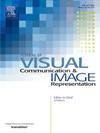Quality assessment of windowed 6DoF video with viewpoint switching
IF 2.6
4区 计算机科学
Q2 COMPUTER SCIENCE, INFORMATION SYSTEMS
Journal of Visual Communication and Image Representation
Pub Date : 2024-12-27
DOI:10.1016/j.jvcir.2024.104352
引用次数: 0
Abstract
Windowed six degrees of freedom (6DoF) video systems can provide users with highly interactive experiences by offering three rotational and three translational free movements. Free viewing in immersive scenes requires extensive viewpoint switching, which introduces new distortions (such as jitter and discomfort) to windowed 6DoF videos in addition to traditional compression and rendering distortions. This paper proposes a quality assessment method via spatiotemporal features and view switching smoothness for windowed 6DoF-synthesized videos with a wide field of view. Firstly, the edges are extracted from video frames to obtain local spatial distortion features by measuring their statistical characteristics through a generalized Gaussian distribution. Then, the synthesized videos are decomposed and reassembled in the temporal domain to intuitively describe the horizontal and vertical characteristics of the temporal distortions. A gradient-weighted local binary pattern is used to measure temporal flicker distortions. Next, to assess the impact of viewpoint switching on visual perception, a velocity model for retinal image motion is established. Finally, the objective quality score is predicted by a weighted regression model. The experimental results confirm that the proposed method is highly competitive.
带视点切换的窗口6DoF视频质量评估
窗口六自由度(6DoF)视频系统可以通过提供三个旋转和三个平移自由运动为用户提供高度互动的体验。在沉浸式场景中自由观看需要大量的视点切换,除了传统的压缩和渲染扭曲外,还会给加窗的6DoF视频带来新的扭曲(如抖动和不适)。提出了一种基于时空特征和视角切换平滑度的宽视场加窗6dof合成视频质量评价方法。首先,从视频帧中提取边缘,通过广义高斯分布测量边缘的统计特征,得到局部空间畸变特征;然后,对合成的视频进行时域分解和重组,直观地描述时间畸变的水平和垂直特征。采用梯度加权局部二值模式测量瞬变失真。其次,为了评估视点切换对视觉感知的影响,建立了视网膜图像运动的速度模型。最后,利用加权回归模型对客观质量评分进行预测。实验结果表明,该方法具有很强的竞争力。
本文章由计算机程序翻译,如有差异,请以英文原文为准。
求助全文
约1分钟内获得全文
求助全文
来源期刊

Journal of Visual Communication and Image Representation
工程技术-计算机:软件工程
CiteScore
5.40
自引率
11.50%
发文量
188
审稿时长
9.9 months
期刊介绍:
The Journal of Visual Communication and Image Representation publishes papers on state-of-the-art visual communication and image representation, with emphasis on novel technologies and theoretical work in this multidisciplinary area of pure and applied research. The field of visual communication and image representation is considered in its broadest sense and covers both digital and analog aspects as well as processing and communication in biological visual systems.
 求助内容:
求助内容: 应助结果提醒方式:
应助结果提醒方式:


